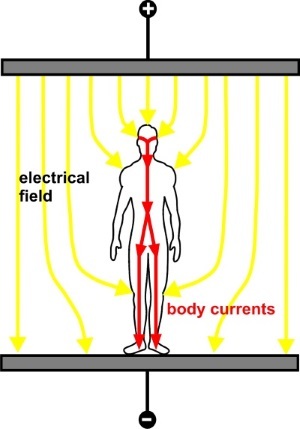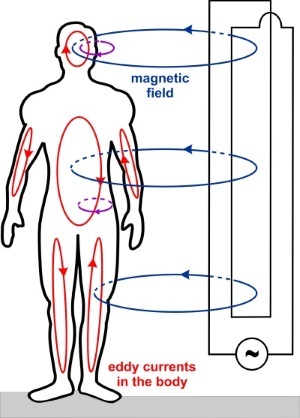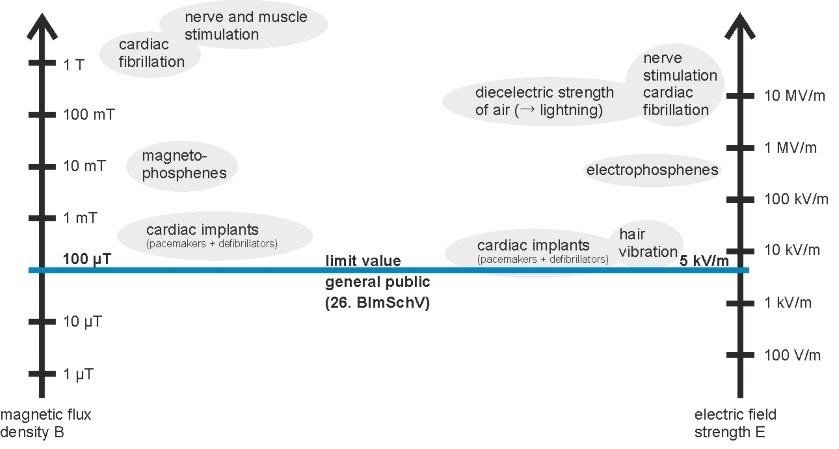Low frequency (0.1 Hz–1 kHz)
Electric and magnetic fields are treated separately in the context of extremely low frequency fields. They have different effects on humans and biological systems. Electric fields and currents are induced inside the body by exposure to extremely low frequency magnetic fields. The fields and currents induced in the body interact with the body´s own electric fields and currents, which play an important role in biological functions (e.g. in the conduction of nerve stimuli or in signal transduction at cell membranes via ion currents. Moreover, extremely low frequency electric fields affect electric currents on the body surface. At low magnetic flux densities or field strengths below the limit values for occupational exposure, these effects are not perceptible in most cases and present no health risk (LUBW, p. 104-105).
In general, the effects of these fields depend on the strength of the fields, the frequency of the fields, the orientation of the body in the fields and the distance between the human and the field source. With growing distance the fields decrease. Also anatomical characteristics (like the cross-sectional area, shape and posture) in relation to the direction of the field and grounding of the body play a role in electric fields.
Extremely low frequency electric fields
External extremely low frequency electric fields are distorted by the presence of a body and create an electric field strength on the body surface by charge transfer, whose strength depends on the size, shape, parts and grounding of the body and its orientation in the field. An electrical surface charging, like e.g. the skin surface and the hairs, is caused like in static fields. Depending on the electric field strengths, these surface effects can be perceptible due to micro-discharges and the movement of hairs, which repel each other and then straighten up. However, there are no known relevant direct health effects of extremely low frequency electric fields to date which could result from charging of the body surface – except for possible stress caused by prolonged exposure to microshocks (cf. Static fields (0 Hz)) (ICNIRP, p. 819).
In addition to these surface effects, external extremely low frequency electric fields cause spatially variable charge densities inside the body by the movement of electrical charges (electrostatic induction). The induced electric field inside the body is several hundred thousand to million times weaker than the inducing external 50 Hz/60 Hz field (ICNIRP, p. 819; LUBW , p. 103). Depending on the body region and the induced field strengths on the body surface, the current densities of induced electric body currents differ (see Figure) and good grounding generally increases these currents. However, the current densities which occur in our everyday lives (e.g. caused by power supply lines) have a maximum value of some mA/m², which is too low to stimulate nerves and muscles, and therefore they are harmless (cf. Figure below, “limit values for perceptible/measureable effects” in section “extremely low frequency magnetic fields”).

Extremely low frequency magnetic fields
Extremely low frequency magnetic fields penetrate the body practically without hindrance. The predominant possible effect is the stimulating effect of the magnetically induced electric fields and body currents (so called eddy currents) inside the tissues (see Figure). The strength of the induced currents depends on the frequency, magnetic flux density and spatial distribution (i.e. field strength at each point in space) of the magnetic field and the area of the body cross section, which is penetrated by the magnetic field. When certain limits are exceeded, this can cause a perceptible stimulation of sensory receptors, nerve and muscle cells (cf. Figure below, “limit values for perceptible/measureable effects”). In this case, polarization effects of ions, which are caused by the fields, play a role, as the stimuli conduction in nerve cells acts via ion currents across the cell membranes.

The body’s own fields, which are created by the natural stimulation of nerves, have current densities of up to 10 mA/m2. Even higher current densities occur locally in the heart muscle and in the brain (LUBW, p. 104). Currents generated by external fields are only perceptible at current densities above 10 mA/m2 by sensory receptors in the skin or eye and can lead to irritations or impairments in the case of repeated exposure. Acute health risks from nerve, skeletal muscle or heart muscle stimulation are only caused by locally induced fields with current densities of more than 100 mA/m2. It depends on the strength of the induced fields and currents whether the effects are reversible or whether irreversible damages up to burns and other tissue damages occur.
The basic restrictions for extremely low frequency alternating fields (cf. Basic restrictions) consist of limit values for (induced) internal electric fields in the body derived from scientific studies (including a safety margin), to rule out irritating, impairing or hazardous body currents. However, as basic restrictions are difficult to measure inside the body, derived limit values (cf. chapter Reference levels) are stated in the guidelines for limiting human exposure to electromagnetic fields. These limit values specify the maximum levels of external electric and magnetic fields to secure compliance with the basic restrictions. The effects occur at different thresholds depending on the frequency of the fields. As an example, the following Figure shows the setting of public limit values for 50 Hz fields. All perceptible and measureable effects occur only above the mandatory limit values.

Phosphenes are visual sensations provoked by so called inadequate stimuli (e.g. mechanical, electrical or magnetic stimulation) even when the eyes are closed. Phosphenes can be caused by magnetic or electric fields, amongst others, and manifest themselves as flashes in the periphery of the visual field. Corresponding to the field type, these effects are called magnetophosphenes and electrophosphenes. They are caused by stimulation of the optic nerve or nerve cells in the retina by induced electric fields in the body tissue.
At frequencies below 100 Hz, phosphenes are provoked in the tissue by induced electric fields of 50-100 mV/m and more (ICNIRP, p. 821). In the case of magnetophosphenes, such induced electric fields in the eye are caused by external extremely low frequency magnetic fields with a magnetic flux density of about 5 mT and more at 20 Hz, at 50 Hz the threshold lies at around 10 mT: see Fig. “Thresholds for the magnetic flux density and electric field strength”; cf. ICNIRP, p. 820; Lövsund et al., 1980). In the case of electrophosphenes, the threshold for the provocation of a stimulus by external electric 50 Hz fields lies at several hundred kV/m (cf. Fig. “Thresholds for the magnetic flux density and electric field strength”). However, electric 50 Hz fields of this magnitude do usually not occur during today’s technical processes or near power lines (BMAS, p. 3).
In general, magnetophosphenes and electrophosphenes are reversible and harmless, similar to hair vibrations in an electric field. However, they may have irritating effects in occupational settings and are therefore prevented by suitable basic restrictions (cf. chapter Basic restrictions). For the public, the basic restrictions are decreased by a factor of 5 in comparison to the occupational exposure limit values, which lie directly below the minimum triggering level of phosphenes (ICNIRP, p. 823).
Serious nerve and muscle stimulation can be caused by external 50 Hz magnetic fields above 500 mT (or by electric fields of several millions V/m, BMAS, p. 3). In the first instance, they can cause ventricular fibrillations. In the case of even stronger fields (at least increased by a factor of 5), nerve and muscle stimulations in the extremities occur, which can lead to involuntary (spasmodic) movements.